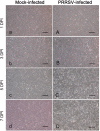Susceptibility of porcine pulmonary microvascular endothelial cells to porcine reproductive and respiratory syndrome virus
- PMID: 32830156
- PMCID: PMC7538327
- DOI: 10.1292/jvms.20-0324
Susceptibility of porcine pulmonary microvascular endothelial cells to porcine reproductive and respiratory syndrome virus
Abstract
Microvascular endothelial cells possess versatile functions and their roles in a variety of viral infections have been documented. Porcine reproductive and respiratory syndrome virus (PRRSV) infection induces severe lung inflammatory lesions in piglets, which is manifested as pulmonary endothelial dysfunction. However, the underlying mechanism of PRRSV affecting porcine pulmonary microvascular endothelial cells (PMECs) remains unknown. This study aimed to evaluate the susceptibility of PMECs to PRRSV. Primary PMECs were isolated and purified from piglet lungs, and the expression of three PRRSV receptors was characterized using immunofluorescence. Overt cytopathic effects of the PRRSV strain HN in PMECs were observed at day five post-infection, and PRRSV antigens in PMECs were determined at both RNA and protein levels using immunofluorescence and quantitative RT-PCR assays. The viral antigen significantly increased at 96 hr post-infection, and infectious virus was recovered from the supernatant of the infected PMECs. The results show that PMECs can be infected with the PRRSV strain HN, and that their receptor expression pattern is different from that of alveolar macrophages. The results of this study shed light on the potential roles of PMECs in PRRSV infection and provide a comprehensive understanding of the pathogenesis underlying its severe manifestation.
Keywords: cytopathic effects; infection; microvascular endothelial cells; porcine reproductive and respiratory syndrome virus; receptor.
Figures







